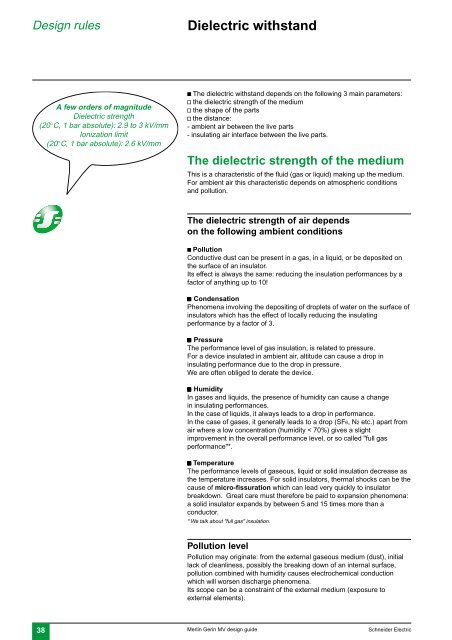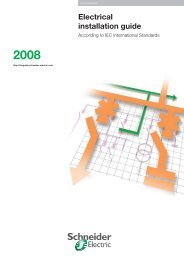MV design guide - Schneider Electric
MV design guide - Schneider Electric
MV design guide - Schneider Electric
Create successful ePaper yourself
Turn your PDF publications into a flip-book with our unique Google optimized e-Paper software.
Design rules<br />
Dielectric withstand<br />
A few orders of magnitude<br />
Dielectric strength<br />
(20°C, 1 bar absolute): 2.9 to 3 kV/mm<br />
Ionization limit<br />
(20°C, 1 bar absolute): 2.6 kV/mm<br />
c The dielectric withstand depends on the following 3 main parameters:<br />
v the dielectric strength of the medium<br />
v the shape of the parts<br />
v the distance:<br />
- ambient air between the live parts<br />
- insulating air interface between the live parts.<br />
The dielectric strength of the medium<br />
This is a characteristic of the fluid (gas or liquid) making up the medium.<br />
For ambient air this characteristic depends on atmospheric conditions<br />
and pollution.<br />
The dielectric strength of air depends<br />
on the following ambient conditions<br />
c Pollution<br />
Conductive dust can be present in a gas, in a liquid, or be deposited on<br />
the surface of an insulator.<br />
Its effect is always the same: reducing the insulation performances by a<br />
factor of anything up to 10!<br />
c Condensation<br />
Phenomena involving the depositing of droplets of water on the surface of<br />
insulators which has the effect of locally reducing the insulating<br />
performance by a factor of 3.<br />
c Pressure<br />
The performance level of gas insulation, is related to pressure.<br />
For a device insulated in ambient air, altitude can cause a drop in<br />
insulating performance due to the drop in pressure.<br />
We are often obliged to derate the device.<br />
c Humidity<br />
In gases and liquids, the presence of humidity can cause a change<br />
in insulating performances.<br />
In the case of liquids, it always leads to a drop in performance.<br />
In the case of gases, it generally leads to a drop (SF6, N2 etc.) apart from<br />
air where a low concentration (humidity < 70%) gives a slight<br />
improvement in the overall performance level, or so called "full gas<br />
performance"*.<br />
c Temperature<br />
The performance levels of gaseous, liquid or solid insulation decrease as<br />
the temperature increases. For solid insulators, thermal shocks can be the<br />
cause of micro-fissuration which can lead very quickly to insulator<br />
breakdown. Great care must therefore be paid to expansion phenomena:<br />
a solid insulator expands by between 5 and 15 times more than a<br />
conductor.<br />
* We talk about "full gas" insulation.<br />
Pollution level<br />
Pollution may originate: from the external gaseous medium (dust), initial<br />
lack of cleanliness, possibly the breaking down of an internal surface,<br />
pollution combined with humidity causes electrochemical conduction<br />
which will worsen discharge phenomena.<br />
Its scope can be a constraint of the external medium (exposure to<br />
external elements).<br />
38 Merlin Gerin <strong>MV</strong> <strong>design</strong> <strong>guide</strong> <strong>Schneider</strong> <strong>Electric</strong>
















